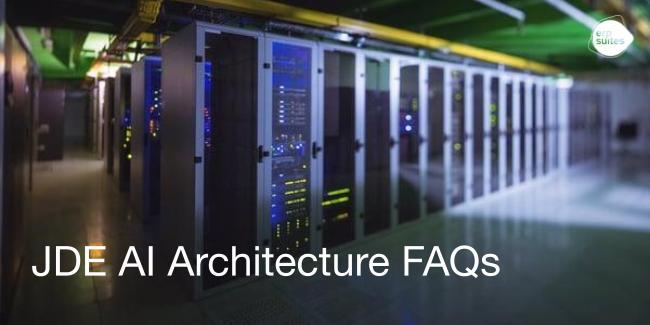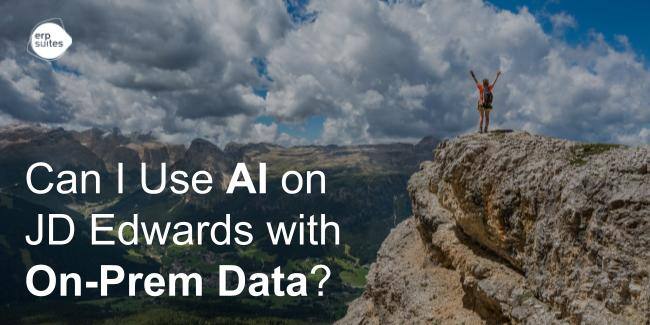Comparing Cloud vs. On-Prem AI Solutions for JD Edwards
June 21st, 2024
6 min read
.png?width=960&height=540&name=Blog%20Images%20(47).png)
If your JD Edwards system is not leveraging AI, you might be missing out on streamlined processes, improved efficiency, and significant cost reductions. AI integration with JDE can revolutionize data management and predictive maintenance.
But with so many options available, choosing between a cloud-based and on-premises AI solution can be challenging. At ERP Suites, with our extensive experience assisting over 300 companies, we understand this dilemma and are here to guide you with hands-on assistance to navigate emerging technology solutions and right size them within their existing JD Edwards ERP system. We’ve worked with numerous clients facing the same tough decision with cloud versus on-prem solutions, and we apply our invaluable institutional knowledge to each different client’s specific needs.
In this article, we will break down the differences between cloud-based and on-premises AI solutions for JD Edwards, covering aspects like scalability, cost, data security, and performance. By the end, you’ll know which option is best suited for your organization’s unique needs. Let's dive in.
Cloud-Based AI Benefits
Cloud-based AI harnesses the capacity of the cloud to utilize the power of AI for a scalable, cost-effective, and quickly deployed business solution. These results can be achieved through on-premises solutions, too, but cloud offers a variety of distinct benefits and advantages. With cloud-based AI, you don’t need to worry about buying or maintaining hardware, and you can access the power of AI through the internet.
Scalability
One of the biggest advantages of cloud-based AI is its scalability. Need more processing power? You can scale up quickly without worrying about purchasing new hardware. For instance, if you suddenly need to analyze a larger dataset than is normally within your purview, you can do so with just a few clicks.
Cost-Effective
Cloud services typically operate on a pay-as-you-go model. This means you only pay for what you use, for as long as they use them, and without any up-front fees or termination charges. This a la carte option is a helpful budgetary option. Pricing can vary by product and usage, but the model is similar to how you might pay for utilities like electricity and water. This can be particularly advantageous for businesses that have fluctuating needs.
Rapid Deployment
With cloud-based AI, you can get up and running quickly. There's no need to wait for hardware to be delivered and installed. This can be a game-changer for businesses that need to implement solutions rapidly.
Challenges of Cloud-Based AI
Going cloud-based for your AI project isn’t a silver bullet guarantee for success. In addition to functional issues that could arise, security issues are top of mind for cloud users.
Data Transfer Costs
Transferring large amounts of data to and from the cloud can be expensive. For data egress (data exiting the cloud), AWS offers 100GB of free data transfer per month, but charges beyond that. Oracle Cloud Infrastructure (OCI) offers more generous limits, with 10TB of free data transfer if you have JDE on OCI. Generally, there is no charge for data ingress (data entering the cloud.)
Data Security and Compliance
Storing data in the cloud can raise security and compliance concerns. Sensitive data might need to remain on-premises to comply with regulations or company policies. AWS is typically more expensive than OCI when it comes to data storage.
On-Premises AI for JD Edwards Benefits
When you use on-premises solutions for your AI projects, you are taking the home court advantage, if you will. Your access and ability to troubleshoot hands-on is much higher than through the cloud, which has both pros and cons. On-premises AI solutions involve setting up the necessary hardware and software on your own servers. This can offer more control and customization.
Data Control and Security
With on-premises solutions, you have full control over your data. This can be crucial for businesses handling sensitive information that must comply with strict regulatory requirements.
Customization
On-premises solutions can be tailored to your specific needs. You can choose the exact hardware and software configurations that best suit your operations. It’s still early days for AI and JD Edwards. Oracle is adding AI features to Oracle Cloud Apps, but not necessarily for JDE. Customers must add AI features themselves, or work with a business partner, such as ERP Suites, to access the AI capabilities they want.
Challenges of On-Premises AI
High Initial Investment
Setting up an on-premises AI solution requires a significant upfront investment in hardware and software. You also need to consider the costs of infrastructure maintenance and necessary upgrades.
Complex Deployment and Maintenance
Implementing an on-premises solution is more complex and time-consuming. You need specialized staff to manage the hardware and software, and to ensure everything runs smoothly. Different qualifications vary and can include at a minimum general cloud computing knowledge, and more specialized certifications such as AI certifications from USAII or ARTiBA, AWS Cloud Practitioner and Solutions Architect Associate or Professional certifications, and OCI Generative AI Professional, OCI Cloud Architect Associate or Professional, among others.
Cost Comparison
Your budget may determine which solution you choose. It’s important to consider short- and long-term costs for both cloud and on-premises options.
Initial Investment
With cloud-based AI, you avoid the hefty upfront costs associated with purchasing various kinds of hardware. Instead, you pay a subscription fee, which can be more manageable for many businesses. On-premises AI requires a significant initial outlay for servers, storage, and other hardware.
Long-term Costs and Data Transfer Expenses
While cloud-based solutions may seem cheaper initially, data transfer costs can add up quickly, especially if you’re moving large amounts of data. For example, as mentioned above, AWS charges beyond 100GB of data transfer, while OCI offers more generous limits, which makes it potentially more cost-effective for JDE customers.
On the other hand, on-premises solutions have higher upfront costs but can be more cost-effective in the long run if managed properly. You won’t have to worry about ongoing subscription fees or data transfer costs, but you will need to budget for maintenance and upgrades. Consider a piece of hardware’s typical lifespan, as well as any potential changes in hardware technology that might make your current equipment obsolete in the future.
Performance and Scalability
It’s important for your cloud or on-premises solution to be able to keep up with your computing needs.
Cloud-Based AI Performance and Scalability
Cloud-based AI solutions are incredibly scalable. Need more computing power? Just adjust your plan. This flexibility is a huge advantage for businesses that experience fluctuating workloads. However, performance can be impacted by internet latency and data transfer speeds.
On-Premises AI Performance and Scalability
On-premises AI solutions offer lower latency since the data is processed locally. This can be critical for real-time applications. However, scaling up can be challenging and costly, as it requires purchasing additional hardware and potentially upgrading your infrastructure.
Security Considerations
No matter where you store it, your data needs to be secure. It might also need to meet certain standards and regulations, in your industry or with the government.
Security in Cloud-Based AI
Cloud providers invest heavily in security, often offering robust protection measures that can be difficult to replicate on-premises. However, concerns about data sovereignty and compliance can make cloud solutions less appealing for some businesses. AWS, for example, offers a government cloud that meets strict regulatory requirements like HIPAA.
Security in On-Premises AI
On-premises AI solutions offer maximum control over your data. You can implement custom security measures tailored to your specific needs. This is particularly important for industries handling sensitive information, such as healthcare and finance.
Customization and Flexibility
Your business is unique to you. Your options need to be, too.
Customization Options in Cloud-Based AI
Cloud-based AI solutions offer a range of ready-made tools and services that can be quickly deployed and scaled. However, customization might be limited to what the cloud provider offers. It’s important to review the capabilities of all potential cloud providers within your budget to make the right decision for your business needs.
Customization Options in On-Premises AI
On-premises solutions offer unparalleled customization. You can choose your hardware, software, and configurations. This is ideal for businesses with specific needs that off-the-shelf solutions can’t meet.
Maintenance and Support
Who will be on call when there’s a problem? You need to know in advance so you can be prepared.
Maintenance Requirements for Cloud-Based AI
Cloud providers handle most of the maintenance, including updates, security patches, and hardware upgrades. This can free up your IT team to focus on more strategic tasks.
Maintenance Requirements for On-Premises AI
With on-premises solutions, your IT team is responsible for all maintenance. This includes hardware repairs, software updates, and security patches. While this gives you more control, it also requires more resources and expertise.
Integration with JD Edwards
Your ERP system of choice is the key ingredient when working with your cloud or on-premises solution. You need to be sure they can easily work together.
Integrating Cloud-Based AI with JD Edwards
Cloud-based AI solutions can be seamlessly integrated with JD Edwards, offering flexibility and scalability. Oracle, for instance, provides pre-built integrations that can simplify the process. However, you need to ensure that data transfer costs and latency don’t impact performance.
Integrating On-Premises AI with JD Edwards
On-premises AI can also be integrated with JD Edwards, offering low latency and high security. However, the process can be more complex and require specialized skills. You might need to work with hardware vendors like Dell, HP, or IBM to get the best setup.
Which AI Solution is Best for Your JD Edwards System?
Deciding between cloud-based and on-premises AI solutions for your JD Edwards system ultimately depends on your unique business needs. If scalability, flexibility, and rapid deployment are your priorities, a cloud-based solution might be the best fit. However, if you prioritize data security, control, and customization, an on-premises solution could be more suitable.
At ERP Suites, our experts are ready to guide you through this decision-making process and help you implement the best AI solution for your JD Edwards system. Get in touch today to start leveraging AI for your business’s growth and efficiency.
Leyla Shokoohe is an award-winning journalist with over a decade of experience, specializing in workplace and journalistic storytelling and marketing. As content manager at ERP Suites, she writes articles that help customers understand every step of their individual ERP journey.



.png?width=650&height=325&name=Blog%20Images%202_1%20(4).png)
.png?width=650&height=325&name=Blog%20Images%202_1%20(5).png)
.png?width=650&height=325&name=Blog%20Images%202_1%20(3).png)
.png?width=650&height=325&name=Blog%20Images%202_1%20(2).png)
.png?width=650&height=325&name=Blog%20Images%202_1%20(1).png)
.png?width=960&height=540&name=Blog%20Images%20(96).png)

.png?width=960&height=540&name=Blog%20Images%20(90).png)
.png?width=960&height=540&name=Blog%20Images%20(88).png)
.png?width=960&height=540&name=Blog%20Images%20(87).png)
.png?width=960&height=540&name=Blog%20Images%20(86).png)
.png?width=960&height=540&name=Blog%20Images%20(85).png)
.png?width=960&height=540&name=Blog%20Images%20(83).png)
.png?width=960&height=540&name=Blog%20Images%20(82).png)
.png?width=960&height=540&name=Blog%20Images%20(80).png)